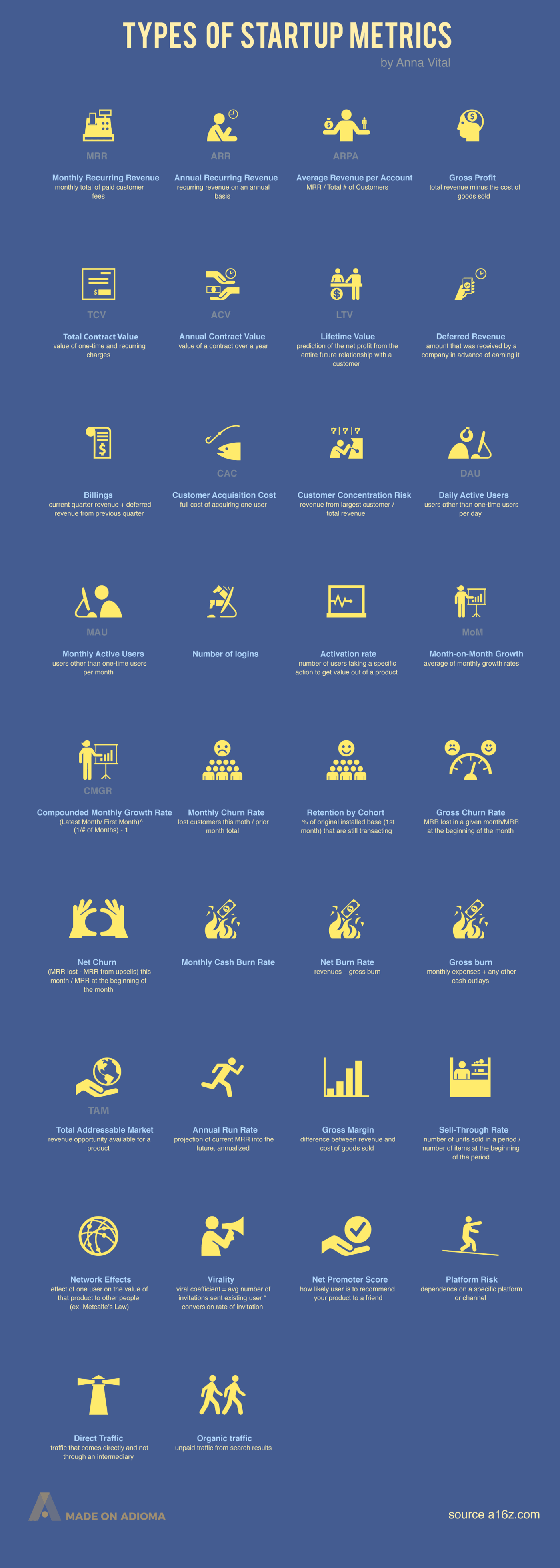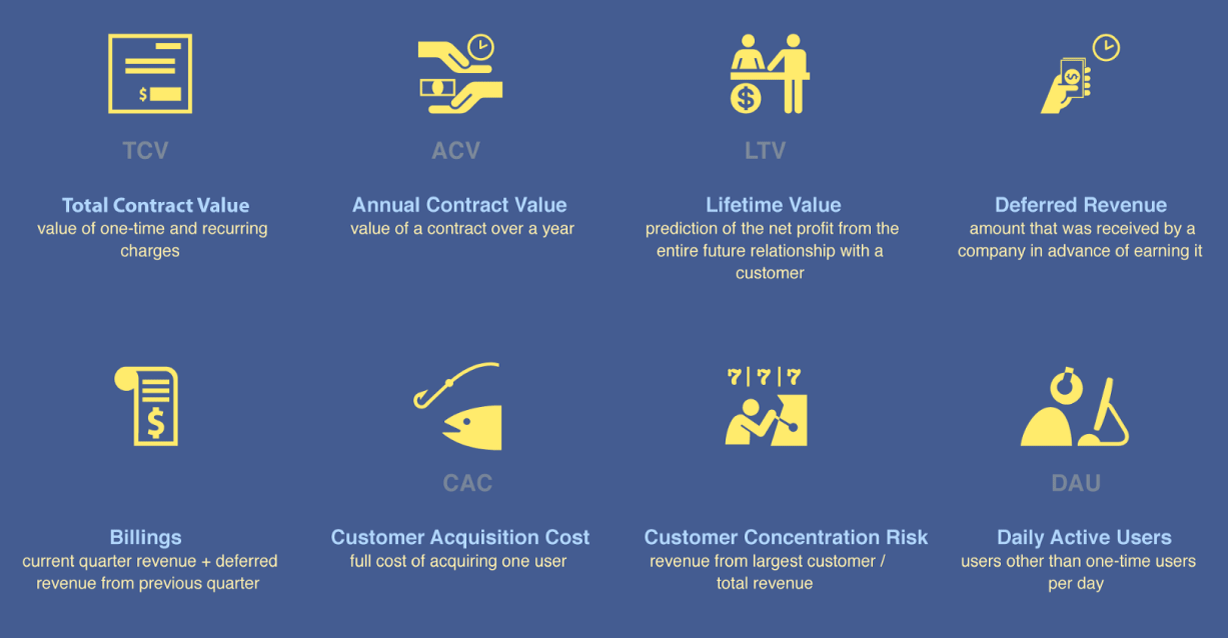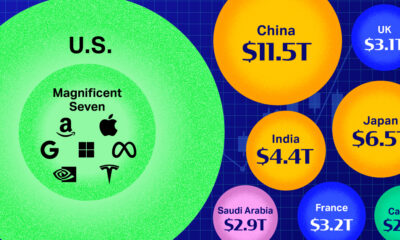Technology
34 Startup Metrics for Tech Entrepreneurs

Courtesy of: Funders and Founders
34 Startup Metrics That Tech Entrepreneurs Need to Know
Today’s infographic comes from Funders and Founders and information designer Anna Vital, and it lists the important metrics to gauge traction and success of new startups.
Several years ago, a key challenge with launching a new tech startup venture was that there weren’t many precedents to follow.
- How do you scale a company?
- How do you measure growth and costs in a more meaningful way?
- Does the company have real traction?
Of course, there were knowledgeable people in the tech ecosystem that knew these things – for example, venture capitalists and ex-founders that had been successful with previous ventures – but they were tough to gain access to, and many of their theories and best practices weren’t yet widespread.
Fast forward to today, and the practices around new startups are much more established. While this can be a blessing and a curse to new founders, at least a more standardized set of metrics helps to give founders a sense of where their company stands.
Key Startup Metrics, According to VCs
The infographic from Funders and Founders lists 34 startup metrics for founders to know – but which one should be a focus for new ventures?
Here’s what three bigtime VCs have said about the startup metrics that they consider to be most important at early stages:
“Month-over-Month Organic Growth”
For most companies, MoM organic growth is a very useful metric and depending on the base, 20–50% MoM growth can be good. Retention, referral, and churn are all things we look at, too.
– Aileen Lee, Cowboy Ventures
According to Aileen Lee, who originally came up with the “unicorn” term, organic growth is a particularly useful metric.
On the other hand, Bill Gurley of Benchmark says that monitoring conversions is a comprehensive metric that is a good proxy for several key business areas.
“Conversion Rate”
No other metric so holistically captures as many critical aspects of a web site – user design, usability, performance, convenience, ad effectiveness, net promoter score, customer satisfaction – all in a single measurement.
– Bill Gurley, Benchmark
Paul Graham, of Y Combinator fame, says that the metric depends on the stage. If you have revenue, then revenue growth is the metric you want. If you’re not there yet, user growth is a good proxy.
“Revenue Growth or Active Users”
The best thing to measure the growth rate of is revenue. The next best, for startups that aren’t charging initially, is active users. That’s a reasonable proxy for revenue growth because whenever the startup does start trying to make money, their revenues will probably be a constant multiple of active users.
– Paul Graham, VC and co-founder of Y Combinator
It should also be noted that the most relevant metric to you depends on your business model. For example, MRR (Monthly recurring revenue) and churn rates would be particularly important to SaaS (Software-as-a-service) startups, while MAUs (Monthly active users) and organic traffic may be more important measurements for online media companies.
Technology
Ranked: Semiconductor Companies by Industry Revenue Share
Nvidia is coming for Intel’s crown. Samsung is losing ground. AI is transforming the space. We break down revenue for semiconductor companies.
Semiconductor Companies by Industry Revenue Share
This was originally posted on our Voronoi app. Download the app for free on Apple or Android and discover incredible data-driven charts from a variety of trusted sources.
Did you know that some computer chips are now retailing for the price of a new BMW?
As computers invade nearly every sphere of life, so too have the chips that power them, raising the revenues of the businesses dedicated to designing them.
But how did various chipmakers measure against each other last year?
We rank the biggest semiconductor companies by their percentage share of the industry’s revenues in 2023, using data from Omdia research.
Which Chip Company Made the Most Money in 2023?
Market leader and industry-defining veteran Intel still holds the crown for the most revenue in the sector, crossing $50 billion in 2023, or 10% of the broader industry’s topline.
All is not well at Intel, however, with the company’s stock price down over 20% year-to-date after it revealed billion-dollar losses in its foundry business.
| Rank | Company | 2023 Revenue | % of Industry Revenue |
|---|---|---|---|
| 1 | Intel | $51B | 9.4% |
| 2 | NVIDIA | $49B | 9.0% |
| 3 | Samsung Electronics | $44B | 8.1% |
| 4 | Qualcomm | $31B | 5.7% |
| 5 | Broadcom | $28B | 5.2% |
| 6 | SK Hynix | $24B | 4.4% |
| 7 | AMD | $22B | 4.1% |
| 8 | Apple | $19B | 3.4% |
| 9 | Infineon Tech | $17B | 3.2% |
| 10 | STMicroelectronics | $17B | 3.2% |
| 11 | Texas Instruments | $17B | 3.1% |
| 12 | Micron Technology | $16B | 2.9% |
| 13 | MediaTek | $14B | 2.6% |
| 14 | NXP | $13B | 2.4% |
| 15 | Analog Devices | $12B | 2.2% |
| 16 | Renesas Electronics Corporation | $11B | 1.9% |
| 17 | Sony Semiconductor Solutions Corporation | $10B | 1.9% |
| 18 | Microchip Technology | $8B | 1.5% |
| 19 | Onsemi | $8B | 1.4% |
| 20 | KIOXIA Corporation | $7B | 1.3% |
| N/A | Others | $126B | 23.2% |
| N/A | Total | $545B | 100% |
Note: Figures are rounded. Totals and percentages may not sum to 100.
Meanwhile, Nvidia is very close to overtaking Intel, after declaring $49 billion of topline revenue for 2023. This is more than double its 2022 revenue ($21 billion), increasing its share of industry revenues to 9%.
Nvidia’s meteoric rise has gotten a huge thumbs-up from investors. It became a trillion dollar stock last year, and broke the single-day gain record for market capitalization this year.
Other chipmakers haven’t been as successful. Out of the top 20 semiconductor companies by revenue, 12 did not match their 2022 revenues, including big names like Intel, Samsung, and AMD.
The Many Different Types of Chipmakers
All of these companies may belong to the same industry, but they don’t focus on the same niche.
According to Investopedia, there are four major types of chips, depending on their functionality: microprocessors, memory chips, standard chips, and complex systems on a chip.
Nvidia’s core business was once GPUs for computers (graphics processing units), but in recent years this has drastically shifted towards microprocessors for analytics and AI.
These specialized chips seem to be where the majority of growth is occurring within the sector. For example, companies that are largely in the memory segment—Samsung, SK Hynix, and Micron Technology—saw peak revenues in the mid-2010s.
-

 Real Estate2 weeks ago
Real Estate2 weeks agoVisualizing America’s Shortage of Affordable Homes
-

 Technology1 week ago
Technology1 week agoRanked: Semiconductor Companies by Industry Revenue Share
-

 Money1 week ago
Money1 week agoWhich States Have the Highest Minimum Wage in America?
-

 Real Estate1 week ago
Real Estate1 week agoRanked: The Most Valuable Housing Markets in America
-

 Business1 week ago
Business1 week agoCharted: Big Four Market Share by S&P 500 Audits
-

 AI1 week ago
AI1 week agoThe Stock Performance of U.S. Chipmakers So Far in 2024
-

 Misc2 weeks ago
Misc2 weeks agoAlmost Every EV Stock is Down After Q1 2024
-

 Money2 weeks ago
Money2 weeks agoWhere Does One U.S. Tax Dollar Go?














